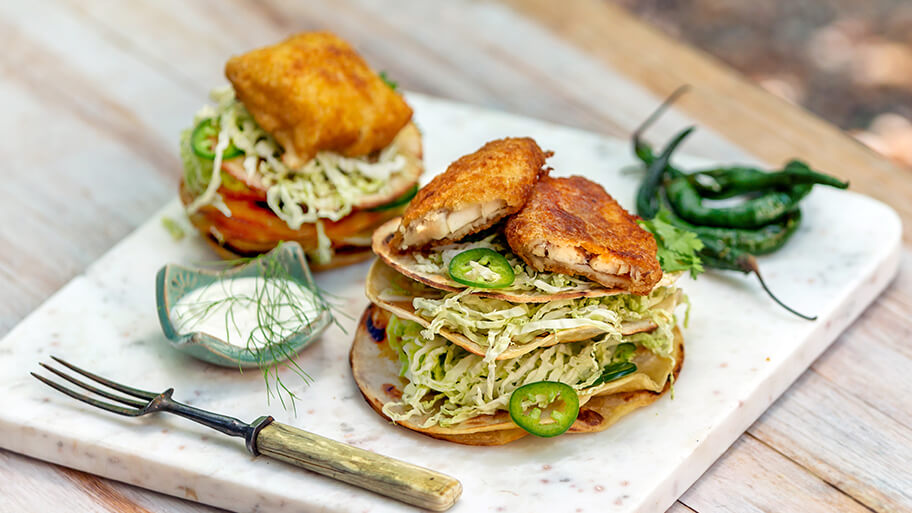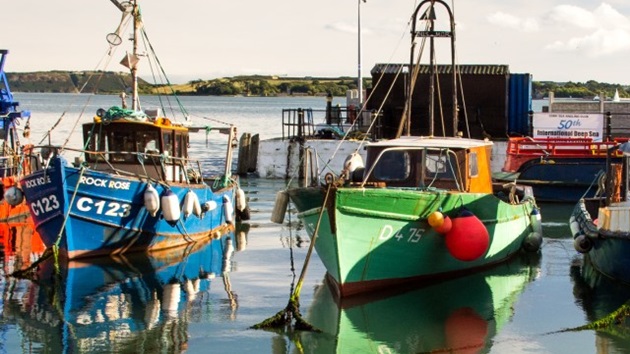Pandemic cocktails, fish tacos on the beach, and a grassroots coral conservation movement in the Philippines. Get to know our newest senior leadership team members—Erika Feller, Americas Regional Director, and Kurtis Hayne, Canada Director—as they discuss their sustainable seafood journeys, pandemic hobbies, and much more.

How did you get involved in the sustainable seafood movement?
Erika Feller: I started out working on conservation policy for a Member of the US Congress. One of the things I found when I was working was that there are a bunch of different approaches to conservation. The one that has always resonated with me is a cooperative approach. It sort of seemed like the most interesting and durable solutions to conservation problems always came when the NGOs and stakeholders, the landowners, the fishermen, and the government got together and worked together to make a lasting solution.
So, I went to work for the Nature Conservancy where collaboration was a central part of their approach. I went first to work on forest conservation projects, and a lot of the projects I worked on brought together several different competing players for the desired collective outcome. I got to be a part of a group of people within the Nature Conservancy working to bring that approach over into fisheries.
From that work, I realized that there was a larger sustainable seafood movement, including leaders like the Marine Stewardship Council, focused on finding realistic, collaborative solutions to the issue of overfishing and resource safeguarding globally. So, I’m excited to be a part of it.
Kurtis Hayne: My first real work in the sector—almost a decade ago now!—was working in the Philippines for a small, grassroots organization focused on sustainable fishing and ocean conservation. Specifically, I managed an education program for Filipino students focusing on coral reef conservation and protection. That experience really taught me about the deep connection between local livelihoods and the ocean and, more specifically, seafood. It was the first time I’d really seen that direct connection so when I decided to move back to Canada it really inspired me to forge a similar pathway back home.
Coming back, though, I realized I’d been somewhat ignorant to the fact that those same connections and communities already existed within Canada in the form of sustainable fisheries and sustainable seafood. So, I got involved in the space with a desire to help protect these valuable resources and contribute to the larger movement. I’m really happy to be able to contribute to these communities’ livelihoods, help facilitate a connection back to sustainable fisheries, and making a long-term contribution to the Canadian marine environment through my work here at the MSC.
So it started in the Philippines and now I'm really happy to be doing that work in Canada, and also abroad with the MSC globally.
What is your number one priority for your work here at the MSC?
Erika Feller: In my experience, one of the key things to do in effective conservation work is meeting your partners where they are. I think there’s a lot of opportunity to do that here in the Americas and beyond. I think there are a lot of fisheries and stakeholders in our region who are in really, really different places. So, I’d love to find a way for the MSC to be central to bringing these players together.
I’m asking myself, ‘how can we bring what MSC has to offer to help make fisheries more sustainable while really helping the participants in those fisheries and communities see how certification can benefit them?' My hope is that I can help improve access to the MSC program across the region.
Kurtis Hayne: I think my number one priority is engaging more with stakeholders in a collaborative way. To grow our effectiveness in Canada—and the larger Americas region—we need to reach more folks, and we need to reach those folks wherever they sit in their sustainability journey. I want to work to bring more diverse voices and stakeholders into the movement.
So, overall, my goal is really growing the effectiveness of our program by growing engagement with our currently engaged partners while also growing the number of new partners and stakeholders within the MSC program.
Which pandemic hobby did you perfect?
Erika Feller: I perfected nothing. I'm not even promising that anything I attempted turned out very good at all, but having all that time at home was a great chance to try things that you’re normally trying to jam into a weekend. Instead, you’re spending all your time at home. So, yeah. I’d put a pork shoulder in the smoker for 24 hours on a random Tuesday and not worry—very set it and forget it.
During the pandemic, I learned how to smoke all kinds of stuff. My favorite things to smoke are pork shoulder and fish—love smoked fish! And there's this great fish market in DC. So, we would take the gigantically long walk over to the Wharf and buy a mess of fish, and then fill up the smoker with it. Of course, it was almost always delicious.
Another hobby I got into was making cocktails. I had a whole long list of cocktails I wanted to make. And so every two weeks I would tackle a new one. I didn’t try to invent any new concoctions—my proudest (and most practical) achievement was making a decent Pisco sour. This feat was especially important to me as it’s probably my favorite cocktail. I think if you’re going to learn how to make one cocktail, make it one you’ll really enjoy.
Kurtis Hayne: Like Erika, I don’t know if I perfect any one hobby. But, like many other folks during the pandemic, I got a lot better at breadmaking, cooking, and gardening. Not to be a cliché, but I practiced making sourdough. Through this exercise, though, I realized I’m going to leave the breadmaking to the professionals—if only for the time commitment for sourdough. I made some pretty good bread, so I know I can do it now. Now, I’m going to leave it to them.
I also got an ice cream maker, so I’ve been making lots of fun ice creams and, occasionally, frozen cocktails! My crowning cocktail moment was this pina colada I made that featured toasted jasmine rice syrup and pandan leaves. I also made Maraschino cherries from a sour cherry tree we have in our backyard.
Erika Feller: When you come to DC next, bring some with you! I could make some Manhattan’s and add your cherries to that. I’m not normally a huge fan of Maraschino cherries but those sound delicious.
Kurtis: Only if you smoke some fish while I’m in town—
Erika: Deal.
What is your most memorable seafood meal of all time?
Erika Feller: There's kind of two ends of the spectrum when it comes to “memorable meals”. When I saw this question, there was initially only one possible answer in my mind and it was in Valparaíso, Chile. I was working for the Nature Conservancy and we got an invitation from Members of the Chilean Senate to go down and do a presentation on what we were doing at the time with fisheries management in California.
So, I flew down, we gave our presentation, and then went out to dinner in Valparaíso, and I don’t even have one thing I remember vividly—it was all so good. What I do remember is being in this restaurant kind of up on the side of the hill with this amazing view. Honestly, it was just such a beautiful city and we had every kind of seafood. I think the thing that stuck out the most to me was how fresh and simply prepared everything was—it was truly beautiful. It was one of those meals where every single thing you put in your mouth seems too perfect to be real.
There’s another special, if not more simple memory that also came to mind. Having fresh fish tacos on a beach in Baja, California was similarly memorable to me, for whatever reason. Something about that experience has always stuck with me.
Kurtis Hayne: I’ve been very lucky to have a lot of really good seafood meals, so this question was a difficult one for me to answer. I think the most memorable, though, was actually when I was in person with the larger MSC Canada team. We did a large event called “Brewery and the Beast” which was a huge barbeque event in collaboration with Whole Foods Market.
We had our Canadian Chef Ambassador Charlotte Langley cook two massive whole halibuts Asado-style over an open fire on these big iron crosses. It was really impressive, if not a little stressful! It all turned out really well, though. We also invited Tiare Boyes, who is now our other Canadian Ambassador join us to talk more about the wild Pacific BC Halibut fishery she fishes in and their sustainability journey. It was really a wholly beautiful spectacle.
How would you describe the future of the sustainable seafood movement in five words or less?
Erika Feller: The phrase that comes to mind for me is, “everyone has got to eat.” We’re looking at the kind of future where we’re going to have serious issues due to climate change and major shifts in food production. We have to have a lot of options on the table when thinking about how to keep the world fed—and sustainable seafood is an important part of that conversation.
Kurtis Hayne: I actually wrote down five separate words, I hope that’s okay! For me, the future of the sustainable seafood movement is urgent, collaborative, pragmatic, adaptive, and expanding.
Similar to Erika, I believe a continued sense of necessity and urgency will move the sustainable seafood movement forward in the coming years.
The MSC is thrilled to have Erika on board leading the Americas region and to have Kurtis steering the MSC Canada ship. Together with Eric Critchlow, US Program Director, and Cristian Vallejos, Latin America Program Director, the MSC looks forward to expanding its reach and fisheries sustainability efforts in the Americas.



